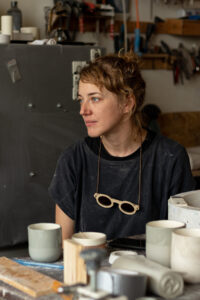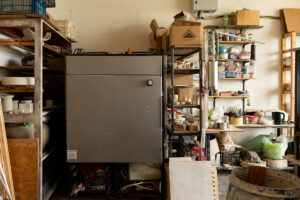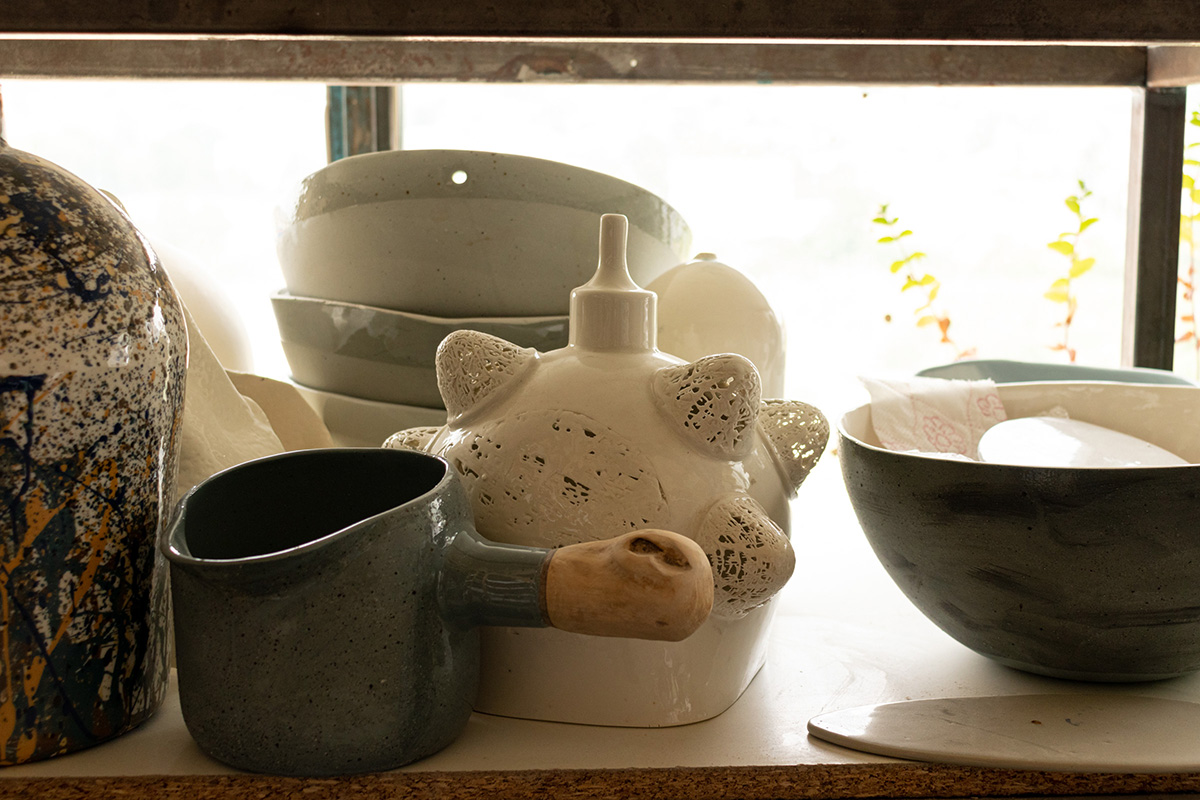
For the ceramics-loving public, Diana and Cătă from LUT Studio are among the brightest and most eagerly awaited presences at fairs and festivals. Although they launched and established themselves in the field a long time ago, they are still perceived as the “junior wing” of Cluj pottery, “utilitarian pottery”, Diana spontaneously and modestly emphasizes, lest it be lumped together with the artistic section.
In fact, when it comes to utilitarian ceramics, especially if you adopt a minimalist aesthetic, it is hard as a ceramist to be original and not fall into “ikeisms”. LUT Studio achieves this rare feat with its objects – vases, mugs, plates, lamps and so on – with an essential yet distinctive design, objects with a unique personality, as if taken from Morandi’s paintings. It is also rare for a couple to be able to materially and coherently translate a creative dialog. Diana (or Magdi to those close to her) talked to us about how to combine industrial solutions with manual techniques, about working as a couple and the qualities that are essential for an aspiring ceramist.

When did you first think or set out to become a potter?
My first contact with ceramics was in 9th grade when I met Mr. Zmicală. Although I didn’t know it yet, but I think that was the defining moment. It was a conscious decision I made when I decided to go to the Ceramics department at the University. Cătă kept visiting us at the department and played in the “mud” for a while, and when we finished college we decided to open a ceramics workshop.

Can you tell us about what it was like and how you felt when you first participated in a ceramics exhibition?
I don’t remember the first exhibition but I can say with certainty that it was rushed, panicked and nervous. Ceramics involves a long and arduous journey and I can’t remember an event where we weren’t running down the corridors with our hot, fresh out of the kiln work.
Which designation do you prefer, ceramicist, potter or visual artist and why?
Definitely CERAMIST. Usually people introduce us as artists or designers but no, we are ceramists ????. I find it encompasses it all but also brings the modesty of working with clay.
What does ceramics mean to you?
More than ‘bread on the table’ it is meditation and play, construction and study, physics and chemistry.

What do you think is the most important quality of ceramic art?
It takes time but it’s forever.
What are your sources of inspiration?
First of all nature through its mixture of chaos and precise mathematical patterns. And tradition, not so much the traditional motifs, but rather the minimalism of “country life”.
Which ceramic materials do you like to use most and why?
Materials should be respected for what they are, with their pluses and minuses. We don’t like materials that pretend to be something else (a tile that you swear is wood). In our projects, we most often work in porcelain because it’s lightweight, durable and translucent, but we don’t compromise on other materials either. Clay is pre-miscible and leaves you room for error, earthenware is creamy and tiles are hard and durable. We are always trying to find a place for them in projects.
Do you use more industrial techniques and technologies dedicated to ceramics or more manual working techniques? What do you think are their pros and cons?
I think harmony is generally in balance. Usually the material dictates the technique and the project chooses the material. We pour in negatives, we shoot on the wheel, we build with slabs and sausages and we recently bought a CNC to keep up with the times. Porcelain casting doesn’t leave much room for modeling, but the objects are fine, light and about the same. Instead, modeling results in more robust, handmade and unique objects.

Can you give us an example of archaic pottery that you particularly appreciate and what is it about it that appeals to you?
I am fascinated by Dogū, the “artistic side” of the Jomon culture (14,000-400 BC).
Dogū are small clay figurines. Most appear to be modeled as female with large eyes, small waists and wide hips, considered to be representations of the mother goddess. It was believed that diseases could be transferred into dogū, which then destroyed, eliminating disease and unhappiness. Full figures are rare, most are missing an arm, leg or other body part.
What do you think are three of the most important ceramic events in the world?
I don’t know if they’re the most important, but they’re definitely at the top of our list:
– NCECA – National Council for Education in the Ceramic Arts
– MINO International Ceramics Festival, Japan
– Gyeonggy Ceramic Biennale, South Korea.
How would you describe your job in three words?
Eager, surprising and satisfying.
What do you think are three of the most important qualities a visual artist should have?
Patience, acceptance and relinquishing control.
Which ceramic artist or artists have inspired you throughout your career or are a reference point?
As a business model, Gaya Ceramics has always been a benchmark for us. The list of artists keeps changing, but right now I can say that I’m following Shay Church intensely.
How does it work in a creative tandem like yours, how do you divide your tasks?
We usually discuss the forms together, then Catalin does the negatives. He is also in charge of the more technical parts (the electrical wiring of the lighting fixtures and the fastening systems for the wall objects). The jobs we don’t like very much, we split them up: Cătă polishes and I glaze. I also take care of organization, paperwork, bureaucracy and public relations. Otherwise, we both do whatever needs to be done.
What aspect of ceramics do you try to transmit/communicate to the “apprentices” who come to work in your studio?
I insist on reminding them that it is more important to enjoy the ‘journey rather than the destination’ and that the ‘destination’ (the burning) must be taken and viewed with responsibility. An object that you rushed will remind you that you “could have given more thought” for another 5000 years.
Interview by Letiția Câmpan.
